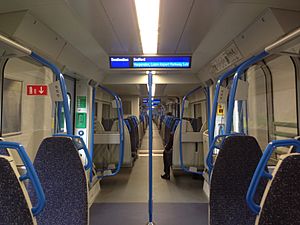Thameslink facts for kids
Quick facts for kids Thameslink |
|
|---|---|

A Class 700 Thameslink train at Blackfriars
|
|
| Overview | |
| Status | Operational |
| Owner | Network Rail |
| Locale | East of England Greater London South East England |
| Termini | Bedford/Luton/St Albans Brighton/Sutton/Sevenoaks Cambridge |
| Stations | 68 (additional stations at peaks) |
| Service | |
| Type | Commuter rail, Suburban rail |
| System | National Rail |
| Services | 5 |
| Operator(s) | Thameslink |
| Depot(s) | Bedford Cauldwell Walk Bedford Carriage Sidings Cricklewood Three Bridges |
| Rolling stock | Class 700 Desiro City |
| History | |
| Opened | 1988 |
| Technical | |
| Number of tracks | 2–4 |
| Track gauge | 1,435 mm (4 ft 8 1⁄2 in) standard gauge |
| Electrification | 25 kV 50hz AC OHLE 750 V DC third rail |
| Operating speed | 100 mph (160 km/h) maximum |
Thameslink is a very important train route in the British railway system. It connects 68 train stations and is about 225 kilometers (140 miles) long. This route runs from north to south, right through the heart of London. It links towns like Bedford in the north to Brighton on the south coast.
Thameslink trains are super handy because they also go to major airports. These include London Gatwick Airport and London Luton Airport. Some trains on this route also go on a loop through areas like Sutton and Wimbledon. On weekdays, another branch goes to Sevenoaks, passing through places like Catford and Bromley South.
This train service started running all the way through London in 1988. By 1998, it became really popular. Over 28,000 people used it during busy morning times. Today, most of the trains on this route are run by a company also called Thameslink.

Contents
What is Thameslink?
Thameslink is more than just a train line; it's a network of services. It helps people travel across London and beyond without changing trains. Imagine going from a town north of London, through the city center, and all the way to the south coast. Thameslink makes this possible. It's a key part of how many people get to work or visit friends and family.
Connecting Cities and Airports
The main purpose of Thameslink is to connect different parts of England. It links towns in the East of England and South East England. It also serves Greater London. This means you can travel easily between places like Bedford, St Albans, London, and Brighton.
A big advantage of Thameslink is its direct links to airports.
- London Gatwick Airport is a major international airport.
- London Luton Airport is another busy airport.
These connections are very helpful for travelers.
How Many Stations and Routes?
The Thameslink route has 68 stations. During busy times, trains might stop at even more stations. There are five main routes that Thameslink trains follow. These routes help cover a wide area and serve many different communities.
The Trains of Thameslink
The trains used on the Thameslink route are modern and comfortable. They are called Class 700 trains. These trains are also known as Desiro City trains.
Features of Class 700 Trains
Class 700 trains are designed for busy routes like Thameslink.
- They are very long, with up to 12 carriages. This means they can carry many passengers.
- They have air conditioning to keep you cool.
- There are digital screens inside that show you the next stops.
- These trains use two types of electricity to run. This allows them to travel on different parts of the railway network.
History of the Thameslink Route
The idea for Thameslink started a long time ago. The goal was to create a direct train service through London. This would make travel much easier for commuters.
When Did it Start?
The Thameslink service officially opened in 1988. Before that, trains would stop at London stations like King's Cross or Blackfriars. Passengers would then have to change trains or use the London Underground to continue their journey. The new service meant trains could go straight through.
Why Was it Needed?
By the late 1990s, Thameslink became very popular. So many people used it that trains often became overcrowded. This showed how important the service was for people traveling in and around London. To help with this, big upgrades were planned for the route.
Thameslink Programme
To make Thameslink better, a huge project called the Thameslink Programme was started. This project aimed to increase the number of trains and make journeys smoother.
What Did the Programme Do?
The Thameslink Programme involved many improvements:
- New trains: The Class 700 trains were bought to replace older ones.
- Station upgrades: Many stations along the route were improved. London Blackfriars station was rebuilt right over the River Thames.
- New tunnels and tracks: New sections of track and tunnels were built to allow more trains to run.
- Better signaling: The system that controls train movements was updated. This helps trains run closer together safely.
This big project helped Thameslink become the modern and efficient service it is today. It allows more people to travel quickly and comfortably across London.
Images for kids
See also
 In Spanish: Thameslink para niños
In Spanish: Thameslink para niños



